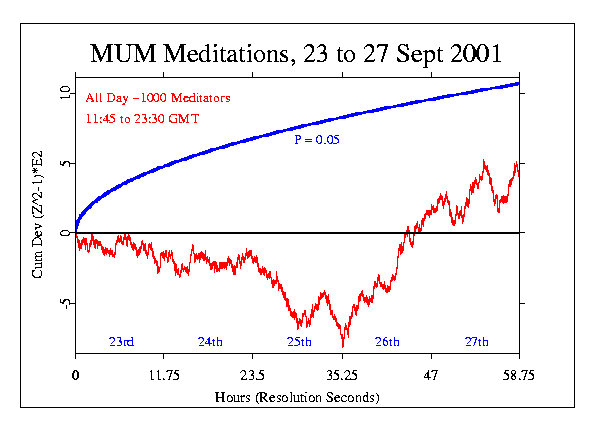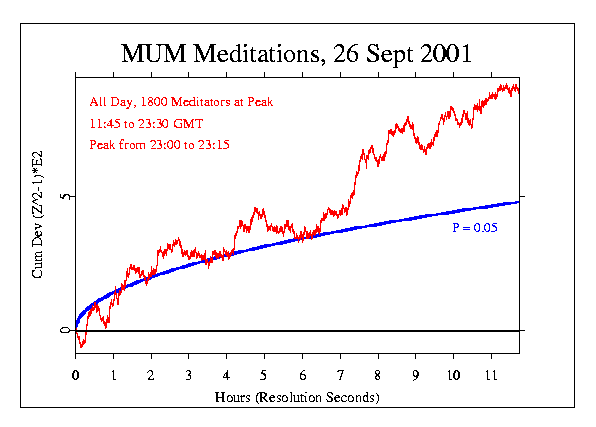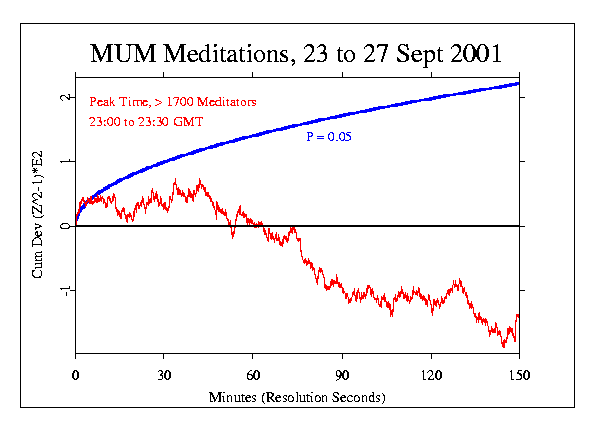|
David Orme-Johnson, a scientist who has a long history of research
using sociological measures of effects from large groups of meditators,
suggested a prediction that the GCP might respond to a large
gathering of people trained in Trancendental Meditation. I had received
similar but less well-formed predictions from other correspondents.
David gave this information:
"After Sept 11 over 1000 meditators came to Maharishi University of
Management (MUM) to meditate together to create an influence of
stability and peace in the country.
Together with the people already here, the number of meditatiors
reached a peak of over 1,800. The
specific days and times of over 1,700, the number we predict will
affect North America, were Sept
23-27, with the most people flying at 7:00 to 7:15 PM EDT. Sept 26
was the peak number, over 1,800."
In his first description,
David said that although, "we have been meditating most of the day
every day, this specific period of
Yogic Flying is predicted to have the most powerful effect, which is
the subjective experience of waves
of bliss. So our theory predicts that there will be a national
effect that is different from the background
meditation at that time, on the 23-27th of Sept. with 26th the max."
I described how we do the GCP predictions and analysis in some detail,
then presented four reasonable
candidate predictions and asked David to choose one that would,
according to his experience and intuitions, nicely represent the proposed
effect. He decided that the full day of meditation over the period of
five days with more than 1700 meditators would be a good choice.
The formal prediction was thus for a departure from expectation in the
data from 11:45 to 23:30 GMT on the five days from 23 to 27 September 2001.
In the following display, the days are
concatenated in sequence, and the axis markings indicate the number of
hours accumulating over the days.
Although not statistically significant, the
results for this formal prediction look very interesting, with two
rather persistent trends, reversing at the beginning of the 26th, when
the peak of 1800 meditators was reached. The statistical result is
Chisquare 211950 on 211500 df, with p = 0.244.

The next figure shows the data for Sept 26 alone.
This is the day of the maximum number of meditators, and the
departure from expectation is steady and unusually strong,
leading to a final result that has a chance likelihood of about one in
1000 (Chisquare 43190, df 42300, p = 0.0012) had it been an a
priori prediction instead of an exploration.

The other most intriguing candidate prediction is for the time during
which a more advanced meditation technique called "yogic flying" is
practiced. There are several times, but the most powerful of these is
in the evening, from 7:00 to 7:30. The following figure shows the
concatenated result for the five days during this time period. The
trend is fairly steady, and goes in the opposite direction from the
GCP's standard prediction. Although this is a non-formal exploration and
is too little data to allow
robust interpretation, such an effect corresponds to a reduction of the
size of deviations from expectation in the nominally random data.
It is worth noting that the Silent Prayer on Sept 14, 2001, showed the
same pattern.
Perhaps we should predict such an effect from deeply focused meditations.

|